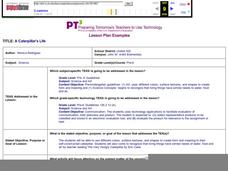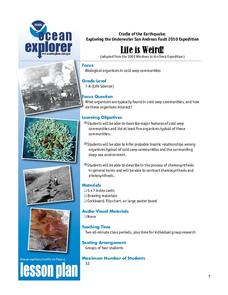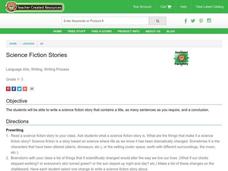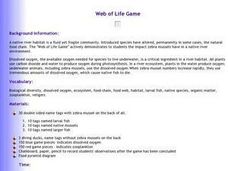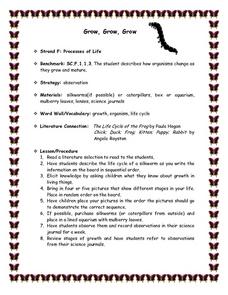Curated OER
A Caterpillar's Life
Students use different colors, surface textures, and shapes to create form and meaning to their caterpillar. They also come to recognize that living things have similar needs of water, food and air by teacher reading The Very Hungry...
Curated OER
Energy in Living Systems
Students are asked: Is our life's purpose over when it's over? What happens to our bodies? They analyze the flow of energy through living systems. Students compare the metabolism of autotrophs with that of heterotrophs. They create a...
Curated OER
What Do We Mean by "Living Things"?
Students discuss the characteristics of life. In this living things instructional activity students complete a lab while working in groups. Students examine different organisms and create a poster to present to the class.
Curated OER
Life is Weird
Students describe features of cold seep communities and investigate five organisms that live there. In this biological organisms activity students research a given species and give an oral presentation on their results.
Curated OER
Making Comparisons of Living Things
In this comparing living things worksheet, students examine pairs of pictures that show living organisms such as a snail, a cat, a butterfly, a giraffe, and a rabbit. They look at pairs of pictures and orally answer questions using...
Curated OER
Life in Space: International Space Station
Students explore the potential challenges of living in space. In this investigative lesson students search the Internet to locate 16 nations that are working together to build the Independent Space Station, then they divide into...
Curated OER
Butterfly Life Cycles
Students study the butterfly life cycle. For this interdisciplinary life cycles lesson, students study the life cycle of a butterfly, their migration habits, and the culture of the region in Mexico where butterflies migrate to in the...
Curated OER
Science Fiction Stories
Students review the story writing process and the elements such as prewriting, drafting, editing, revising, publishing, and assessment. Next students write a science fiction story that contains a title, the requested number of...
Curated OER
Living in a Watershed
Fourth graders examine watersheds. In this ecosystem lesson, 4th graders discover what a watershed is and identify the local watershed they live in. Students investigate the attributes of a watershed as well.
Curated OER
Biomedical Engineering and Quality of Life Improvements
Young scholars complete an observational or natural science experiment. They do systematic and experimental work using experiments that have been done by others. They research their hypothesis and gather information from several...
Curated OER
Life Cycle of a Butterfly/ Moth
Students explore the life cycle of butterflies, illustrate the life cycle of the butterfly, and compare the researched facts to stories written by Eric Carle about caterpillars and butterflies.
Curated OER
Blue Planet: Seas of Life
Students study coral reefs and marine communities. In this investigative lesson plan students get into groups and are assigned a subject. In their groups they create a poster about their assigned topic.
Curated OER
Living with Visual Impairments
Students study what causes visual impairment and disability later in life. In this visual impairments lesson students complete lab activities that includes assisting a person with vision problems.
Curated OER
Life in the Kelp Forest
Young scholars research and create a marine food web to learn about plants and animals in a kelp forest. For this marine food web lesson, students draw lines between kelp forest predators and prey and show the flow of energy in the food...
Curated OER
Living With the Heat: The Ring of Fire
Students investigate the planet Earth's infamous ring of fire and the life that thrives from it. In this ocean environment lesson, students investigate hydrothermal vents and how organisms thrive off their heat. Students...
Curated OER
Water: H2O = Life
In this earth science worksheet, students explore and describe animals and their adaptations, including their habitats, physical characteristics, and competing organisms. They also explore and describe how others use water around the...
Curated OER
This Life Stinks
Students study how organisms that live in cold seep communities get energy from methane. In this organism lesson students write a brief report and identify oxidation reduction reactions and explain if these are dependent of...
Curated OER
Life in a Drop of Water
Students observe the wealth of living organisms in a drop of water from our freshwater ecosystems. They classify the types of organisms observed as single-celled or multi-cellular and use a key or chart to identify and name the organisms...
Curated OER
Web of Life Game
Students participate in a web of life game. After reviewing new vocabulary, they play each round of the game and discuss the changes that occured in the last round. They are to survive in the game as long as possible given the...
Curated OER
Science NetLinks: Changing World 1: Endocrine Disruptors
Students investigate how environmental surprises and endocrine disruptors influence perceptions of benefits and costs. The decisions of science are under these type of influences and must be thought out with a definite method.
Curated OER
Monarch Egg
Students investigate the stages of the Monarch butterfly and its life cycle. In this butterfly life cycle lesson, students discuss when, where, and how the Monarch butterflies lay their eggs. After discussion, students...
Curated OER
Through the Eyes of an Owl
Students describe vertebrates in terms of observable body parts and characteristics and describe life cycles of familiar organisms. They identify familiar organisms as part of a food chain or food web and describe their feeding...
Curated OER
Grow, Grow, Grow
Students listen to literature selection, describe life cycle of silkworm, discuss what they know about growth in living things, observe silkworms for one week and record observations in science journals, and review stages of growth.
Curated OER
Beautiful Bugs
Students investigate the life cycle of ants, ladybugs, and butterflies. They list the four stages of the butterfly life cycle, define symmetry and observe how ants make homes in dirt.
